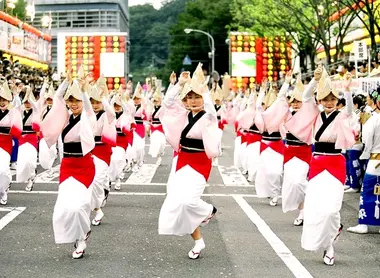O-bon matsuri お盆祭
- Published on : 21/06/2016
- by : I.D.O.
- Youtube
Visiting spirits
In summer in Japan, fireworks light up the sky from north to south of the islands. Joyful and colourful festivals are held, where the Japanese reconnect with their old traditions and stroll dressed in yukata (a summer light cotton kimono). This is also a time for them to commemorate their ancestors.
O-bon, translates as 'o', an honorific prefix, and 'bon' meaning lantern. The traditional name was Urabon, a Japanese translation of the Sanskrit term Ullamabana, meaning 'terrible affliction', and it is the Japanese festival of the dead. It comes from a Buddhist belief that the souls of the dead return to earth three days a year to visit their relatives (July 15 in the old lunar calendar once used in Japan, and between August 13 and 16 in the Gregorian calendar).
Welcome back
The exact rituals vary across regions and different Buddhist sects, but the principle remains the same: families "host" the souls of the dead and do everything to make their brief return to Earth pleasant. First, they put lanterns or burning pieces of wood in front of their front door to light the way; This fire is called mukaebi, "the home fire". Tradition also requires them to make a "horse" - a cucumber with four stick legs to serve as a mount for the souls, and a "cow" made of an eggplant, also with four small stick legs, to carry their luggage. Nowadays, you can buy pre-made sets (with statuettes made of straw) in supermarkets: a perfect example of the cliche that Japan is "a modern country that has preserved its traditions"!
Three days of celebration
When the spirits have returned home, the family make offerings of food (the food that their ancestors liked, or sometimes alcohol, according to their earthly tastes!) on the family altar, present in all Japanese homes. Against remuneration, a monk of the temple where the ancestors are buried will say prayers at the family's home. On the last day, the families light the okuribi, a fire to escort the spirits back to heaven. Some people put the "spirit of the deceased" in small square paper lanterns, toro, that they deposit on a river or in the sea, to help them find the way to paradise. This results in a delightful waterfront celebration named toronagashi or shoronagashi.
In the city of Kyoto, the celebration called Daimonji Okuribi Gozan attracts thousands of people who come to pray for their ancestors and marks the end of Obon. On August 16, huge fires (almost 200 meters long) in the shape of Chinese characters are lit and burn for thirty minutes on the mountains of the ancient imperial capital. The most famous is located on Mount Nyoigatake, where the huge ideogram "dai" (大), meaning big, sets the hill aflame and can be seen from kilometers around. The spectacle of this Kyoto night is unique and quite extraordinary.
Let's Dance!
Within the walls of some Buddhist temples, Shinto shrines and sometimes in the squares of towns or villages, a platform is built, on and around which a traditional dance, Bon Odori, is performed in the evenings. The Bon dance, performed to the sound of flutes and Japanese drums. This dance was originally intended to welcome the spirits. Each region has its own particular dance and music.
Nowadays, it is mostly the elderly or young children, usually dressed in yukata, participating in the dance.
Like all traditional festivals (matsuri), yatai (food stalls) are present and we can enjoy yakisoba (fried noodles), takoyaki (fried octopus in batter) kakigori (shaved ice drizzled with syrup) and other dishes specific to matsuri, not to mention the beer!
The atmosphere is friendly, the lamps that illuminate the scene impart a magical feeling, and everyone is invited to the party, so feel free to join the participants and try a truly authentic experience! To find this kind of festivity, look at the entrances of temples or shrines in your neighborhood, and see if they have posted a Bon Odori program. By region, the festival takes place in mid-July (in the case of Tokyo, in general) or from 13 to 16 August.
If you want to attend larger celebrations, don't miss the following:
- In Gifu Prefecture, Gujo Odori festival in the city of Gujo, lasts for thirty-two nights! A month of dances and festivities where everyone can participate. This is also an opportunity to enjoy many regional folk dances. The last days of the festival (from 13 to 16 August), the troops of dancers take turns all night for a non-stop show from 8pm to 5am.
- On the island of Shikoku, the city of Tokushima is famous for its Awa Odori dance festival that dates from 1578 and which attracts thousands of spectators in mid-August (from August 12 to 15).
- In Tokyo, in mid-August, go to Sumida Shinsui Terrace Park, near the Azuma-bashi bridge where thousands of paper lanterns are floated on the Sumida River. You can buy one, write a wish and your wishes are carried away with the water...
- In Hiroshima, where more than 150,000 people perished in the atomic bombing, a commemorative ceremony is held every August 6th. In the evening, thousands of lanterns are floated on the Motoyasu River, just upstream of the Memorial Hiroshima Peace Park.

























